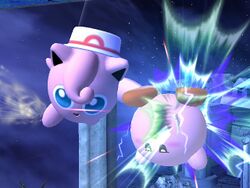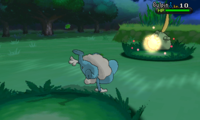Pound: Difference between revisions
(No tournament bans Pound... lol) |
(→Rising Pound: CPU Trivia) |
||
| Line 16: | Line 16: | ||
==Rising Pound== | ==Rising Pound== | ||
As pressing up quickly after using Pound causes Jigglypuff to gain height, and the move does not put it into [[helpless]] state, Pound gives Jigglypuff a gigantic horizontal recovery. Quickly performing "upwards" Pounds is called rising pound. Contrary to popular belief, this is not infinite, as the ending lag causes Jigglypuff to end up slightly lower than its original position. However, it still gives it a great advantage in stalling, being able to go under many stages and go to the other side. | As pressing up quickly after using Pound causes Jigglypuff to gain height, and the move does not put it into [[helpless]] state, Pound gives Jigglypuff a gigantic horizontal recovery. Quickly performing "upwards" Pounds is called rising pound. Contrary to popular belief, this is not infinite, as the ending lag causes Jigglypuff to end up slightly lower than its original position. However, it still gives it a great advantage in stalling, being able to go under many stages and go to the other side. | ||
After using all of Jigglypuff's mid-air [[jump]]s, [[CPU]]s use this move repeatedly until they recover, or eventually be [[KO]]'d. | |||
==Origins== | ==Origins== | ||
Revision as of 06:15, January 12, 2012
| Pound | |
|---|---|
 Pound in Brawl. | |
| User | Jigglypuff |
| Universe | Pokémon |
Pound is the name of Jigglypuff's neutral special move in Super Smash Bros. and side special move in Super Smash Bros. Melee and Super Smash Bros. Brawl. It is a short-range attack that sends Jigglypuff forward a short distance with its arm out in front of it to punch. Pound is very useful when recovering, as it can be used between jumps to give Jigglypuff more horizontal distance. This technique is required to beat Bonus 2 in Super Smash Bros.
In Melee and the original, Pound knocked the opponent up and behind Jigglypuff, while in Brawl, it only has vertical knockback.
Although the Pound is mostly used for recovery and movement purposes, it can also be utilized as an effective attack. The Pound is a useful move that has a hitbox that stays out longer than one would expect, causing opponents to drop their guard too early at times. In certain situations, the Pound can also serve as a set-up for Jigglypuff's powerful Rest attack. Pound is also useful as an attack in Brawl due to its hitbox gaining the shield damage effect, causing it to deal heavy damage to an opponent's shield should they shield it.
Rising Pound
As pressing up quickly after using Pound causes Jigglypuff to gain height, and the move does not put it into helpless state, Pound gives Jigglypuff a gigantic horizontal recovery. Quickly performing "upwards" Pounds is called rising pound. Contrary to popular belief, this is not infinite, as the ending lag causes Jigglypuff to end up slightly lower than its original position. However, it still gives it a great advantage in stalling, being able to go under many stages and go to the other side.
After using all of Jigglypuff's mid-air jumps, CPUs use this move repeatedly until they recover, or eventually be KO'd.
Origins
Pound is based off a move of the same name in the Pokémon RPGs. In the Pokémon games, Pound is a basic physical Normal-type attack with no additional effects, similar to both Tackle and Scratch. Like both, Pound is either naturally known or learned at a very low-level by many Pokémon. In Gen. I-IV, Pound and Scratch are slightly superior to Tackle though, since their base Power is 40 instead of 35 and have an Accuracy of 100 instead of 95; In Gen. V, Tackle was given 50 Power and 100 Accuracy in Gen. V, making it stronger than either. Due to its very low base power and the existence of superior Normal-type attacks, Pound is completely ignored in competitive play, being an attack for low-level Pokémon to have while being raised, before being taught more powerful moves.


